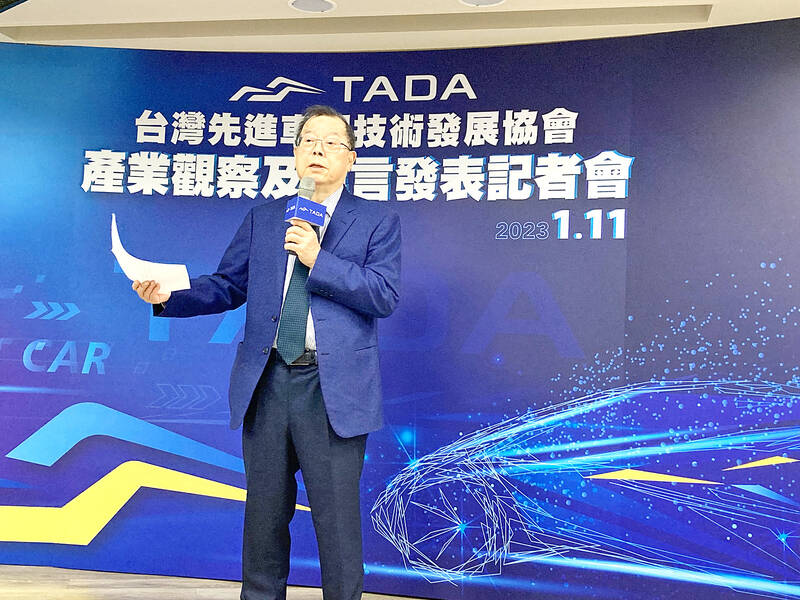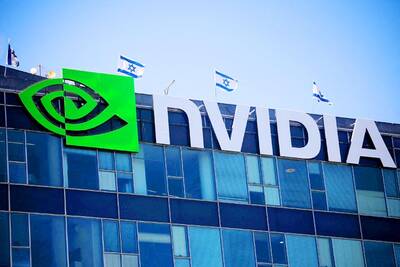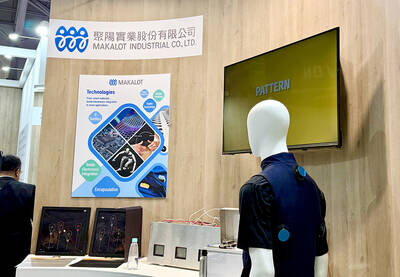Powerchip Semiconductor Manufacturing Corp (力積電) is in preliminary talks with multiple Indian conglomerates to help build new chip plants in the country, it said yesterday, as India subsidizes local chip capacity buildup.
The statement from the maker of memory chips and power management ICs confirmed speculation in the past six months that it was looking to invest in India to diversify its operations amid mounting geopolitical tension.
The company was following similar moves by Taiwan Semiconductor Manufacturing Co (TSMC, 台積電), United Microelectronics Co (聯電) and Hon Hai Precision Industry Co (鴻海精密).

Photo: Lisa Wang, Taipei Times
Tata Group was reportedly one of the possible partners in talks with Powerchip over building a semiconductor fab. Powerchip declined to disclose which companies it is in discussions with.
It is becoming a trend for Taiwanese semiconductor firms to expand operations globally, after TSMC announced its first US semiconductor investment plan, worth US$40 billion, Powerchip said.
“Local semiconductor companies now have to think more seriously about globalization than before,” Powerchip chairman Frank Huang (黃崇仁) told reporters on the sidelines of a news conference in Taipei arranged by Taiwan Advanced Automotive Technology Development Association.
“We are preparing to sign an agreement with India to help it build a plant. It is determined to build one. We are trying to figure out how to support them since we have had similar experience in China,” Huang said.
As India imposes high import duties on semiconductor, it is more cost effective for Indian firms to build a local chip plant, he said.
Powerchip’s parent company, Powerchip Investment Holding Corp (力晶創新投資控股), in October 2015 formed Nexchip Semiconductor Corp (晶合集成) with the Sichuan provincial government to build and operate a fab in Chengdu, China.
Nexchip makes less-advanced chips such as display driver ICs using 150-nanometer and 90-nanometer processes.
Powerchip Investment Holding owns about 27.44 percent of Nexchip Semiconductor shares and a 23.49 stake in Powerchip Semiconductor.
As the talks in India are in the initial stage, Powerchip said it is unclear what role the company would play — as a technology supporter or an equity investor of a joint venture.
US-China trade disputes are positively affecting Taiwanese manufacturers, as Chinese firms and US companies with operations in China are looking for a second source to prevent their shipments from being blocked by Washington, Huang said.
“Taiwan is the best provider of a second source,” he said.
He said he expects Powerchip’s business to start to rebound in the second half of this year, after major supply chain inventory adjustments end following COVID-19 disruptions.
Some notebook computers are still in the process of digesting excessive inventory, he said.
“The first quarter will be the bottom,” he said.
Powerchip said it is cutting factory utilization to cope with sluggish demand, but its loading rate is not as low as some chipmakers that halved production in an attempt to weather the downturn.
The company said it is also facing delays of about six months in ramping up a new 12-inch plant, dubbed the P5 fab, in Miaoli County’s Tongluo Science Park (銅鑼科學園區) due to an extended lead time for semiconductor manufacturing equipment.

Shares in Taiwan closed at a new high yesterday, the first trading day of the new year, as contract chipmaker Taiwan Semiconductor Manufacturing Co (TSMC, 台積電) continued to break records amid an artificial intelligence (AI) boom, dealers said. The TAIEX closed up 386.21 points, or 1.33 percent, at 29,349.81, with turnover totaling NT$648.844 billion (US$20.65 billion). “Judging from a stronger Taiwan dollar against the US dollar, I think foreign institutional investors returned from the holidays and brought funds into the local market,” Concord Securities Co (康和證券) analyst Kerry Huang (黃志祺) said. “Foreign investors just rebuilt their positions with TSMC as their top target,

REVENUE PERFORMANCE: Cloud and network products, and electronic components saw strong increases, while smart consumer electronics and computing products fell Hon Hai Precision Industry Co (鴻海精密) yesterday posted 26.51 percent quarterly growth in revenue for last quarter to NT$2.6 trillion (US$82.44 billion), the strongest on record for the period and above expectations, but the company forecast a slight revenue dip this quarter due to seasonal factors. On an annual basis, revenue last quarter grew 22.07 percent, the company said. Analysts on average estimated about NT$2.4 trillion increase. Hon Hai, which assembles servers for Nvidia Corp and iPhones for Apple Inc, is expanding its capacity in the US, adding artificial intelligence (AI) server production in Wisconsin and Texas, where it operates established campuses. This

H200 CHIPS: A source said that Nvidia has asked the Taiwanese company to begin production of additional chips and work is expected to start in the second quarter Nvidia Corp is scrambling to meet demand for its H200 artificial intelligence (AI) chips from Chinese technology companies and has approached contract manufacturer Taiwan Semiconductor Manufacturing Co (TSMC, 台積電) to ramp up production, sources said. Chinese technology companies have placed orders for more than 2 million H200 chips for this year, while Nvidia holds just 700,000 units in stock, two of the people said. The exact additional volume Nvidia intends to order from TSMC remains unclear, they said. A third source said that Nvidia has asked TSMC to begin production of the additional chips and work is expected to start in the second

Garment maker Makalot Industrial Co (聚陽) yesterday reported lower-than-expected fourth-quarter revenue of NT$7.93 billion (US$251.44 million), down 9.48 percent from NT$8.76 billion a year earlier. On a quarterly basis, revenue fell 10.83 percent from NT$8.89 billion, company data showed. The figure was also lower than market expectations of NT$8.05 billion, according to data compiled by Yuanta Securities Investment and Consulting Co (元大投顧), which had projected NT$8.22 billion. Makalot’s revenue this quarter would likely increase by a mid-teens percentage as the industry is entering its high season, Yuanta said. Overall, Makalot’s revenue last year totaled NT$34.43 billion, down 3.08 percent from its record NT$35.52